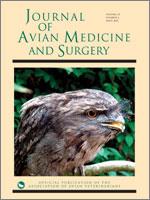Although the use of indirect methods for measuring blood pressure has become commonplace in dogs and cats, it is uncertain whether these methods can be extended to avian species with any proven accuracy or precision. To evaluate the precision of indirect blood pressure measurement in conscious psittacine birds by the Doppler flow method, 25 psittacine birds, weighing between 230 and 1263 g and representing 17 commonly kept species, were examined. Birds were manually restrained, and indirect blood pressure measurements were obtained by placing a cuff around the limb proximal to a Doppler ultrasonic flow detector held over either the basilic or cranial tibial artery. Three sets of 3 measurements were obtained from each wing and leg site, with cuff size and site based on pilot study data identifying the selection criteria of cuff placement with the least variance among repeated measurements. A mixed-effects linear regression analysis was performed to evaluate the differences among mean blood pressure measurements in the individual bird, obtained from the wing versus leg site as well as from 3 different cuff placements at each site. Results showed variation attributable to the limb was not significant. However, blood pressure measurements varied significantly between cuff placements on the same limb from the same bird and among individual birds. The precision of these indirect blood pressure measurements was poor. From these results, the meaning and value of Doppler-derived indirect blood pressure measurements obtained in psittacine birds remains in question, warranting further research.
How to translate text using browser tools
1 June 2011
Precision of Repeated, Doppler-Derived Indirect Blood Pressure Measurements in Conscious Psittacine Birds
Matthew S. Johnston,
Leslie A. Davidowski,
Sangeeta Rao,
Ashley E. Hill
ACCESS THE FULL ARTICLE
Avian
Doppler
indirect blood pressure
precision
psittacine birds





